Happy New Year, starting things off in a crabby fashion
Some reflections on Dungeness, in praise of shellfish stock, and a quick crab salad from a long-ago cookbook project
Happy New Year to you all! I know we’re just a few days in, but I hope 2025 is off to a good start for you. And I hope some of your recent celebrations, and recent cozy dinners at home, have included delicious seafood. Things were very low-key around here, though we had occasion to enjoy some outstanding seafoods. Including some of those tinned things that can be so perfect for any occasion, including sardines in tomato sauce I’d recently ordered from Conservas Pinhais in Portugal, and the classic smoked oysters from Ekone here in Washington.
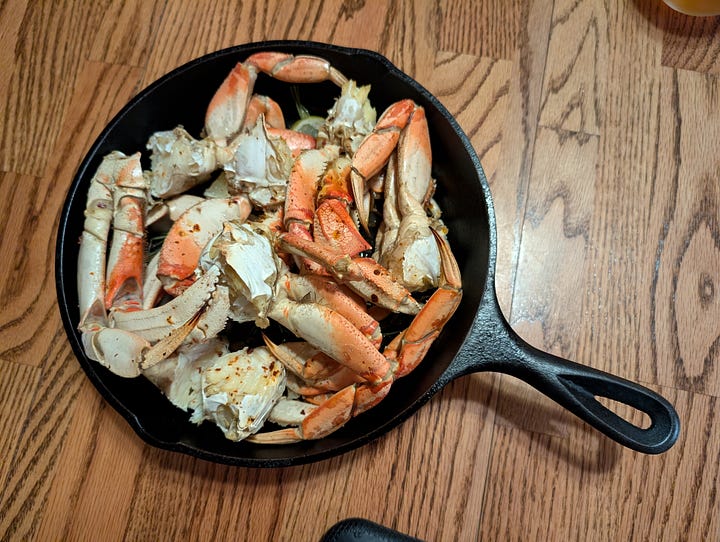
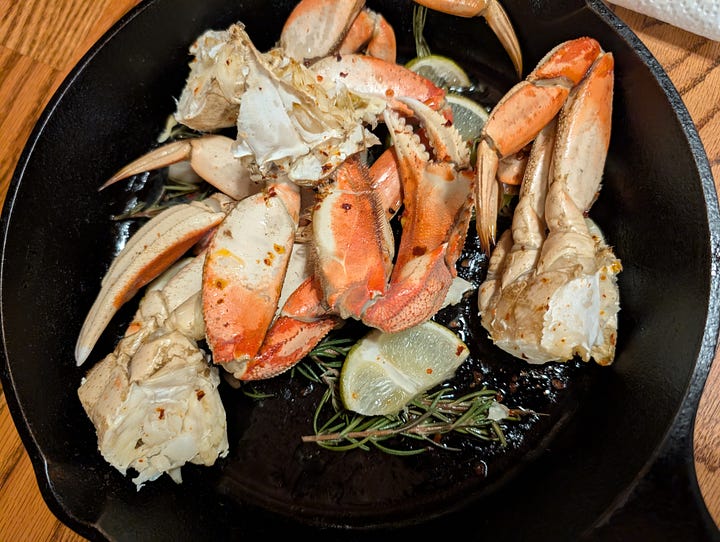
On the cozy side of things, we spent a few days up in the San Juan Islands, on Orcas Island to be exact. It’s a place I love so very much, right up there with Paris as one of my favorite spots on the planet. I shared a bit about a wonderful springtime trip last year in this issue. Wintertime is extra relaxing, mellow, cozy. Sure, often rainy and cold, but we lucked out with stretches of sunny weather for exploring. Staying in one rainy evening was perfect for enjoying a cabin version of one of my favorite recipes from my Crab cookbook, you’ll find the recipe here. Thankfully the crab portions were small enough that they fit in the castiron pan, as no larger baking dish was available. Tucked underneath are fresh rosemary sprigs, garlic, and lime (usually lemon, lime was pretty tasty too), with a good sprinkle of Aleppo pepper on top—items I happily thought to pack with us. Baked until heated through and aromatic, it’s such an easy and delicious preparation. The cooking juices that settled to the bottom of the skillet were divine.
These crabby reflections make me realize I haven’t written all that much about crab here thus far. As a lifelong Northwesterner, I’m of course a committed member of Team Dungeness, though am quick to confirm that I’m really most interested in the most delicious crab wherever I may be. You will definitely see me enjoying blue crab while traveling east, as I have on recent Maryland and Virginia trips.



About 25 years ago I was dreaming up a series of single-subject books focused on Northwest foods, and chose to launch the series with Crab, which came out in 2002. Cherries, salmon, wild mushrooms, apples, oysters…other NW regional foods seemed to already get decent coverage. Dungeness crab felt due for a solo spotlight and what a fabulous time I had writing that one. (I got as far as salmon, wild mushrooms and stone fruit in that series.)
One crabby item from an earlier newsletter that I’d also written about in the cookbook is about what I call Crab Math—that is, roughly how much crabmeat you usually get from one crab, to help you compare price-per-pound for crab in the shell vs pre-picked bulk crabmeat. And to help you know that if you need 8 ounces of meat, you’ll want a whole crab that weighs about 2 pounds. Though as noted below, a huge benefit of in-shell crab is having the shells with which to make a batch of shellfish stock. So, math or not, I recommend that option when it’s feasible.
I’ll share more crab tales down the line. For now will point out that picture above from a Kodiak Island trip years ago, gathering crab prior to a village potluck that evening. Few things express delicious simplicity better than a crab (king, blue, Dungeness…any of them) that goes directly from the pot in which it was caught, to the pot in which it will cook—then simply shelled and enjoyed in its purest form. You can bet that was a dining experience I won’t soon forget. And it’s an example of what’s fed my career-long love of and fascination with seafood.
Shellfish Stock
This is based on recipes from my Crab and Shellfish cookbooks, and really serves as a simple template to work from anyway. In the crab cookbook I included a recipe for Lemongrass Broth with Crab Wontons, for which crab shells were roasted, then simmered with lemongrass, ginger, other aromatics. Simplifying that to simmer shells with just onion, celery, a few herbs makes for a still-flavorful but more neutral base for countless soups, stews, and other recipes. It’s the same approach I used in Shellfish, adding shrimp shells and/or lobster shells to the mix. I sure miss those recipe-testing days when I always had some bags of the stock in the freezer.
Stock made with shells as is will certainly be delicious. The optional step of roasting the shells before simmering adds a wonderful depth of flavor and a subtle toasty element.
This photo I had on hand includes some leek greens too—a perfect example of room for variation. You can add some carrot, if you wish, though I often don’t include carrot in fish or shellfish stocks as its flavor can be more pronounced in these lighter stocks than it is in meat-based stocks.

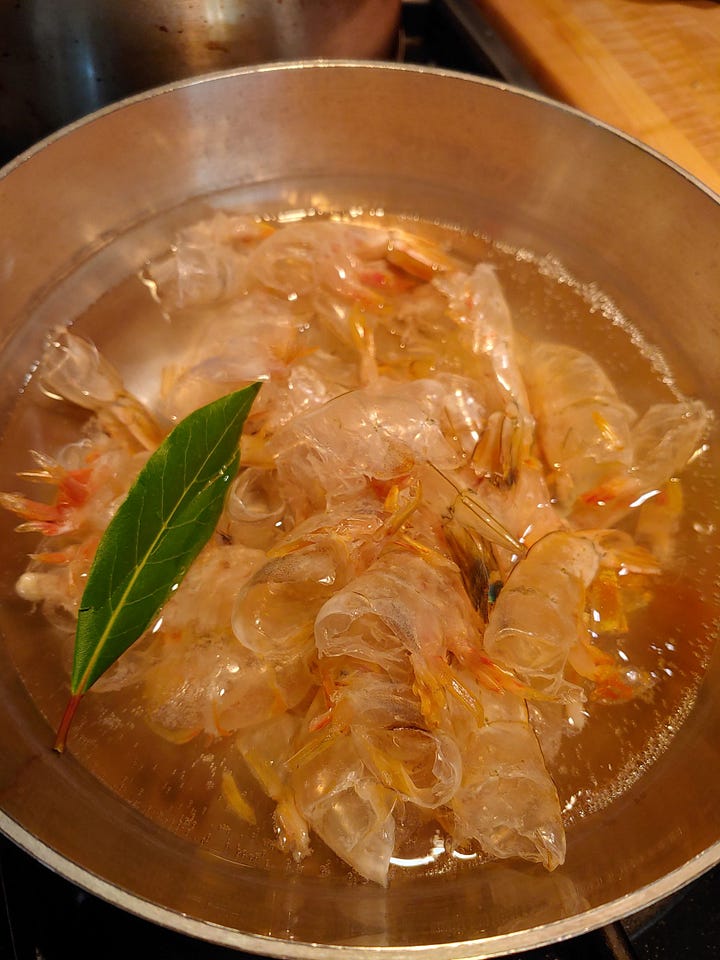
A couple things to share about the quantity of shells called for:
Don’t feel you need to wait until a big feast when you’ll have enough shells to make a full batch. If you have a couple of lobster tail shells, or shells from one Dungeness you’ve picked meat from, or shells from a couple pounds of shrimp—just toss them in an airtight container for storage in the freezer. Add other shells as you cook other things over a month or two. Then you can make your stock with the accumulated shells (mixing crab, lobster, and shrimp shells together is great; just don’t include the carapaces).
Feel free to halve the recipe if you want to use up a smaller amount of shells while you’ve got them; reduce the amount of other ingredients accordingly.
If you have just shrimp shells, they give off their flavor rather quickly, so require less volume and less simmering time; even if you have just a few handfuls of shells, you can make a quick version scaling back the other ingredients (about 1 cup each onion and celery, a thyme sprig, a bay leaf, a few peppercorns) and simmering just 20 to 30 minutes. Even without any aromatics added, the simmered shells can produce a nice simple stock.
Whatever stock you don’t plan to use within a couple of days should be frozen in airtight containers. Freeze in recipe-friendly portions, so you can thaw just what’s needed; I usually freeze in quarts. The stock will be fabulous for recipes such as seafood-oriented risottos, stews, soups, and sauces.
There is no salt in this recipe, so you have control over seasoning whatever dish the stock will be used in. This is particularly important if the stock will be reduced, which would amplify its saltiness had it been pre-seasoned.
About 1 1/2 pounds shrimp, crab, and/or lobster shells (not including carapaces), rinsed
1 medium yellow onion, coarsely chopped
2 large or 3 medium stalks celery, sliced
8 to 12 parsley stems (optional)
2 or 3 sprigs fresh thyme
1 bay leaf, preferably fresh
8 to 10 whole black peppercorns
Optional: Preheat the oven to 400 F. Scatter the shells in a baking dish and roast until they are aromatic and lightly browned, 20 to 25 minutes, gently stirring once or twice for even roasting. Transfer the shells to a stockpot. If any juices are baked onto the baking dish, add a cup of warm water and stir to dissolve them, adding the liquid to the pot.
If not roasting the shells, put them directly into the stockpot.
Add the onion, celery, parsley stems, thyme, bay leaf, and peppercorns to the shells with enough cold water to mostly cover the ingredients (about 3 quarts), and bring just to a boil over medium-high heat. Reduce the heat to medium and simmer until aromatic, about 1 hour. The water should just bubble lightly rather than roil, reduce the heat if needed. After the simmer, take the pot from the heat and let cool until almost room temperature, which allows more time for the flavors to be drawn from the ingredients.
Line a fine-mesh sieve with a thin clean kitchen towel or a double layer of cheesecloth (in a pinch, dampened paper towel). This is important given there may be some tiny shell pieces that could pass through the sieve. Set the sieve over a large bowl, slowly pour the stock through it. Discard the shells and vegetables and set the stock aside to cool. Store the stock in airtight containers, a few days in the refrigerator, up to 9 months in the freezer.
Makes about 2 1/2 quarts
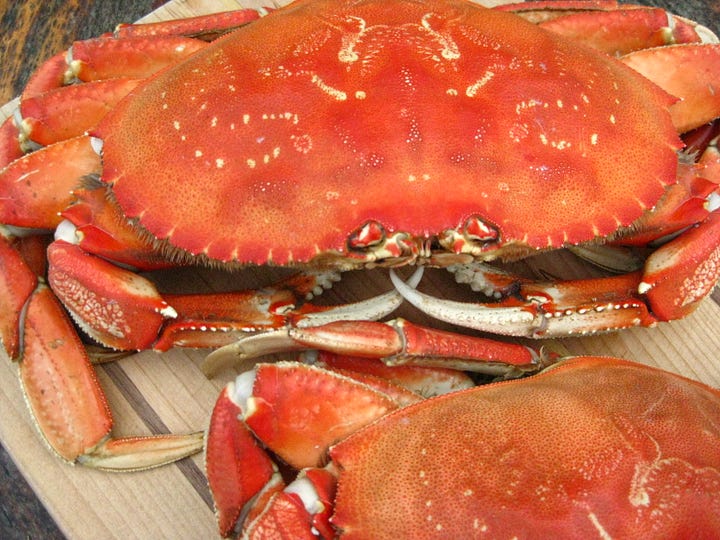
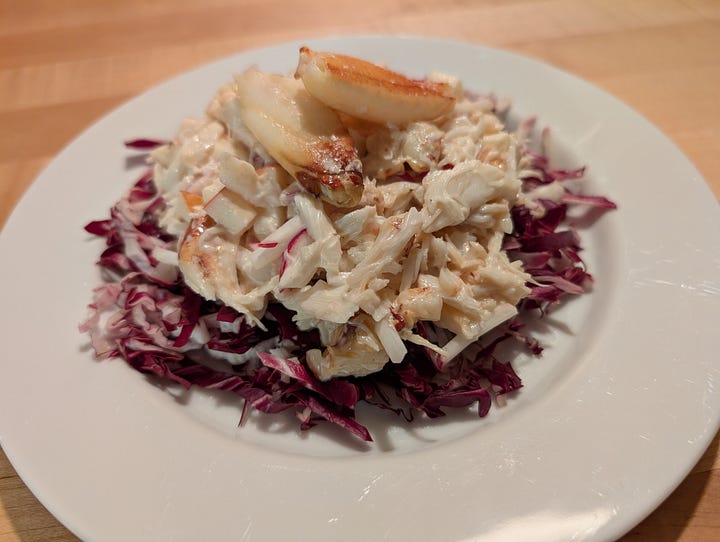
Dungeness Crab with Red Radishes and Braeburn Apples
Among the 30-ish cookbooks I’ve been part of in some way over the years (author, co-author, editor, etc.), five were in a series of “Best Places” cookbooks that included recipes from a wide range of restaurants, inns, cafes, B&Bs, bakeries, etc. in the Pacific Northwest. One of those, the Best Places Seattle Cookbook, I worked on with my dear friend Kathy Casey. It was published in 2001 and included this recipe that, a couple decades later, I still remember being a favorite from when I originally did the editing and recipe testing for the book.
Yesterday I bought a gorgeous Dungeness crab to pick the meat from for use in the salad—among first-of-the-season harvest from off the Oregon coast, I believe the season opened mid December. Following my own advice above, I’m freezing those shells for a not-too-far-in-the-future batch of shellfish stock. I failed to remember to buy some arugula, but had radicchio on hand, so I went with that as a variation on the theme.
The recipe originally came from Philip Mihalski, chef and owner of Nell’s restaurant near Green Lake in Seattle. As I went through the recipe for the first time in ages yesterday, I made some slight adjustments to the original. Here’s my updated version.
2 tablespoons mayonnaise
2 teaspoons freshly squeezed lemon juice [I subbed white wine vinegar, no lemon in the house]
8 ounces Dungeness crabmeat
1/4 cup diced Braeburn apple
1/4 cup julienned red radish
Salt and freshly ground black pepper
2 ounces arugula, rinsed and dried [I subbed slivered radicchio]
Stir together the mayonnaise and lemon juice in a medium bowl until smooth. Set aside 2 to 4 larger pieces of crabmeat for garnish. Add the rest of the crab, the apple, and radish to the bowl. Toss to mix evenly, then season to taste with salt and pepper.
Arrange the arugula in the centers of individual plates. Mound the crabmeat mixture in the center, top with the reserved crab pieces, and serve.
Makes 2 to 4 servings




